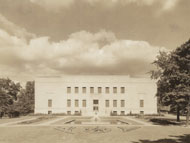The ethnographic collections were started with the addition of Native American artifacts.
1913
Alfred Twining, the Associate Editor of the Scranton Times and foremost botanist in the region, donated his Herbarium to the Museum, along with many historical objects and photographs.
1917
Acquisition of the Sturgis Japanese Art Collection.
1920
The Museum's collections now numbered more than 2,300 bird specimens, 50 fish, 400 mammals, 150 reptiles, 35 amphibians, 2,100 botanical specimens, 25,000 shells, 300 fossils and 800 minerals. Consistent with display techniques of the time, the collections in the original building were on permanent display in a series of large period 19th century wooden cases.
1929
Colonel L.A. Watres led a museum expedition to Panama and the specimens he retrieved from this trip were donated to the Museum's Collection. As was popular at the time, a large collection of plaster casts of classical sculpture were donated by Mrs. Benjamin Dimmick.
1920s & 1930s
Colonel Watres added a large amount of local artifacts, previously in the collection of Dr. H. Hollister, to the Native American collection. Mr. and Mrs. John Law Robertson lent significant pieces of American Folk Art and African and Oceanic Art for exhibit in the Everhart Museum in 1934. Most of these two collections were later acquired by the Museum in the years 1946 to 1948 through the generosity of Mrs. Isabel R. Scott, daughter of the Robertsons.
1965
The museum receives a large grant of contemporary art through the American Federation of the Arts.
1969
With the support of the Museum Association of Scranton, an important collection of Dorflinger Glass was acquired.
1980
The single most significant addition to the African and Oceanic collections occurred when the Museum purchased the collection of anthropologist David Eisler, who worked extensively in Papua New Guinea.
1991
The most recent acquisition to the Natural History Collection was a full-scale articulated stegosaurus skeleton, donated by Attorney Michael Roth.
Today
The Everhart Museum continues to augment all aspects of its existing collections. Works are purchased by or donated to the Museum.















